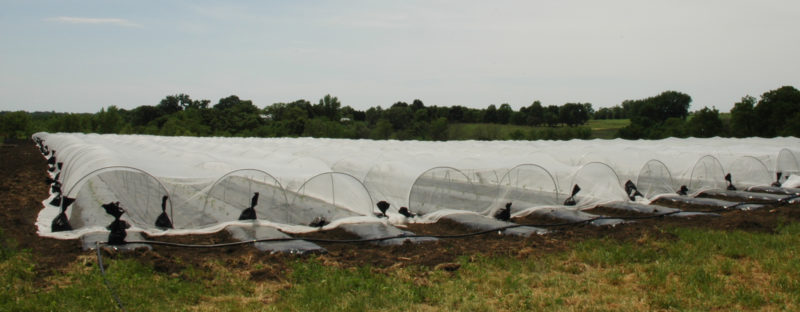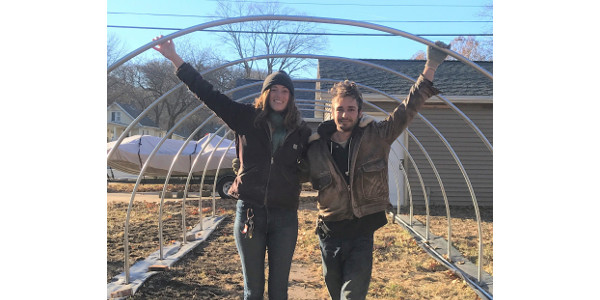
If you’re a vegetable grower, you’re probably familiar with high tunnels and low tunnels. But what are mesotunnels? All three of these tunnel types are used to create some sort of protective barrier between crops and the environment. “Meso” means “middle,” so mesotunnels are medium-size tunnels – taller than low tunnels and shorter than high tunnels. But mesotunnels fit into a niche that’s different from either of the other types. If tunnel types were cousins, mesotunnels would be first cousins to low tunnels and maybe third cousins to high tunnels. Mesotunnels and low tunnels are similar in that they are set up and taken down in the same growing season. High tunnels are long-term structures that stay in the same place year after year – or if they move, they don’t move much. Despite being first cousins, low tunnels differ from mesotunnels in form and function when it comes to cucurbit crops. There are many variations, but typical low tunnels are about 18 inches high. They are covered with a spunbonded polypropylene fabric (for example, Reemay or Agribon) that is supported on wire hoops. They have many uses. But for cucurbit crops in the field, the most common function is to protect the crop early in the season – from cold, high wind, hail, and insect pests. Warming inside the low tunnel can speed up plant growth. With low-tunnel protection, it’s possible to plant earlier in the spring and get earlier yield. Mesotunnels are different. For one thing, they are a lot taller – about 36-42 inches – than low tunnels. The covering is also different: a breathable nylon-mesh fabric (brand names include ProtekNet and others) that resembles window screen. Mesotunnels have a different set of advantages compared to low tunnels. Their larger scale and more breathable covering (which prevents overheating even in midsummer) mean that mesotunnels can potentially be used throughout the growing season. This type of protection is different from low tunnels, which have to be removed when flowering starts in order to avoid overheating and overcrowding the plants. Full-season crop protection by mesotunnels could be a key advantage in organic cucurbit production, especially where pest insects and the disease pathogens they carry create problems all season. Organic insecticides are fairly weak against major cucurbit pests like cucumber beetles, squash bugs, and squash vine borers. To make matters worse, cucumber beetles carry the bacterial wilt pathogen, Erwinia tracheiphila, and squash bugs carry the cucurbit yellow vine disease (CYVD) pathogen, Serratia marcescens. Strong pest pressure and weak insecticides are reasons why many organic growers already use some form of tunnels. Since mesotunnels don’t hold much heat, they probably won’t help much with earliness. But like low tunnels, mesotunnels can protect against damage from hail and high winds. Mesotunnels have additional flexibility in that you can spray pesticides through the nylon-mesh fabric of mesotunnels, but not through the spunbonded polypropylene of low tunnels.Small-plot field trials with mesotunnels in Iowa showed that they increased marketable yield in organic muskmelon and acorn squash compared to low tunnels – sometimes dramatically. But how will this play out at a commercial scale? We’re doing more trials to answer that question. There are at least three important practical questions inside that last question. These need to be solved to make mesotunnels a viable alternative for cucurbit growers. First, how will pollination be done? Second, how will weeds be controlled? Third, under what scenarios would mesotunnels make sense economically? The next couple of blogs in this series will drill deeper into these questions and explain how we hope to answer them over the next few years. *Photo from ISU Current Cucurbit Mark Gleason mgleason@iastate.edu – ISU Current Cucurbit |

